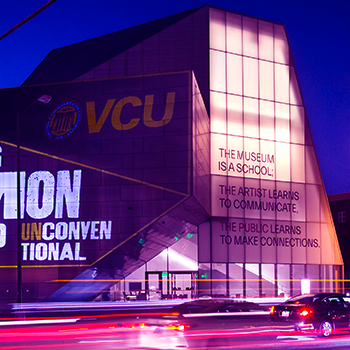
Opinions expressed in AGB blogs are those of the authors and not necessarily those of the institutions that employ them or of AGB.

The Institute for Contemporary Art’s Markel Center on Broad Street in Richmond, Virginia.
Credit: Virginia Commonwealth University
In today’s higher education environment, universities and colleges are advised to constantly communicate with key stakeholder groups. Although this is good advice, we must do more than communicate. We must influence—influence outstanding students and faculty members to join us, alumni and friends to give to us, and the public and political leaders to support us.
This is a precarious moment for higher education because public perception has changed, with more students and parents questioning the value of degrees. Boards and presidents must prioritize building strong brands to generate the influence needed to achieve key goals—enrollment, philanthropy, research, and more—to fulfill their institutions’ missions.
Board members and presidents must protect their institutions’ tangible and intangible assets, the foremost being their brands. Although boards do not create the brand, they have fiduciary responsibilities to understand how senior administrators are shaping and influencing external communications that define and reinforce those brands in the public and educational arenas.
Board members should ask questions and hold administrative leaders accountable for what they are doing to cultivate the institutional brand. I spoke with several leaders recently regarding this imperative.
“Branding is important because it differentiates us, it clarifies our value, and tells people what we stand for,” said Dale Whittaker, PhD, adviser and principal officer for higher education at the Gates Foundation, and former president and provost at the University of Central Florida.1
When I spoke with Whittaker, he said the reputation of the higher education sector, as well as that of individual institutions, “has been severely deteriorated,” and institutions need urgent action to break out of “the sea of sameness” with their brands.2
Whittaker is not alone in this assessment. Earlier this year, college and university leaders at a Yale higher education summit unanimously agreed that “universities need to do a better job of conveying their value proposition.”3
The question for boards and administrations is how to do it.
The first step in creating or refreshing your brand is to clear your path of obstacles. This means tackling preexisting beliefs—branding myths—that too often deter institutions from telling their stories in ways that influence outcomes.
Through debunking these myths with truths, institutions can create how-to guides for branding that accelerate progress toward achieving key goals.
Myth 1: We are a big, complex institution; we could never create a brand that captures all we do.
With multiple colleges, schools, research centers, and initiatives, each serving distinct audiences, some universities might believe no brand could possibly capture it all. But the truth is, an enterprise brand is not just possible—it is essential. Without a unified brand, institutions risk becoming fragmented, with individual units competing for attention rather than reinforcing a shared identity.
My boss, Michael Rao, PhD, president of Virginia Commonwealth University (VCU), put it this way when we spoke: “Without an enterprise brand, you run the risk of having an organization that looks more like a bunch of scattered blocks than it does a smooth pyramid. Your brand is your identity, and unless it is consistent throughout, it becomes meaningless.”4
VCU recently created an enterprise brand that spans the university and its health system, VCU Health. With the board’s strategic guidance, this work included combining VCU and VCU Health’s historically separate marketing and communications teams into its first integrated branding, communications, and marketing division for both the university and the health system. (See the article, “Unafraid to Tell Our Story: How VCU’s Board Leadership Built a New Brand,” in the September/October 2023 issue of Trusteeship.)
A strong enterprise brand provides clarity, amplifies institutional strengths, and enhances reputation. It does not erase the distinctiveness of individual schools or programs; rather, it elevates them under a shared narrative.
Truth: Branding in higher education is not about limiting complexity; it is about making complex concepts meaningful.
Myth 2: Branding is more art than science, and it is nearly impossible to measure return on investment (ROI).
At times in my career, I have been told that branding and storytelling are intangible efforts with little measurable impact or ROI. The reality is that marketing and communications are powerful tools that drive business outcomes.
To ensure accountability, boards and presidents should demand that their marketing/communications teams provide clear metrics tied to institutional priorities. These often include:
- Brand health: What are the trends for aided and unaided awareness, favorability, and consideration among key audiences? (Aided awareness is when audiences need prompts to recognize your institution; unaided awareness means they know you without prompting.)
- Applications and conversions: Are marketing efforts attracting and converting the right applicants into enrolled students? What is the cost per conversion?
- Reputation and rankings: Are peer and public perceptions improving over time? What do the institution’s positive placements in national media look like?
- Website and social media: Are digital campaigns driving engagement and audience growth?
Truth: By aligning brands with strategic goals and measuring impact, colleges and universities can do more than just tell their stories … they can shape their futures.
Myth 3: We need to share more facts, then people will understand who we are.
Facts alone do not inspire action. To truly connect with audiences, institutions must lead with storytelling that centers on human experiences and evokes genuine emotion.
People make decisions based on emotion first, then rationalize with facts. A compelling story about a first-generation student or a researcher making a breakthrough discovery captures attention and builds an emotional connection.
“Effective communication isn’t just about informing. It’s about inspiring change. It answers the big questions: Why are we changing? What’s the value? Where will we be when we get there?” the Gates Foundation’s Whittaker told me. “Real transformation happens when communication taps into emotion and motivation.”5
His advice provides key guideposts, and boards would be wise to ask for examples of how their institutions are capturing and communicating significant personal stories.
To be clear: This approach is not about ignoring facts. It is about making them meaningful. Once engaged with an emotional story, audiences are more receptive to the data that reinforce an institution’s impact.
Truth: Do not just inform your audiences, inspire them. Connect with hearts first, and minds will follow.
Myth 4: Branding is too expensive and takes too long; we do not have the money or time to research and develop a new brand campaign.
Building a strong, unified brand does not require a massive budget or endless timelines. It does require intentionality: thoughtful research, clear messaging, and strategic execution.
The key is creating a brand that is authentic, aspirational, and distinctive. With those in place, even modest investments can yield powerful results. A well-defined brand strengthens the entire institution.
In the long run, the absence of a strong brand is far more expensive—measured in missed opportunities, lost relevance, and diluted impact.
Boards should have a “noses in, fingers out” approach built on trust, while ensuring that branding initiatives align with the institution’s mission and strategy.
Truth: The question is not whether your institution can afford branding; it is whether you can afford not to invest in it.
Higher education is evolving, and institutions that embrace branding as a strategic tool—not just a marketing function—will lead the way. Boards and presidents do not need to be branding experts, but they do need to champion the role of branding in advancing their mission.
A strong brand creates influence and ensures that when people think about your institution, they do not just know what you do—they believe in who you are.
For boards, this means understanding the brand’s value as an intangible asset, asking the right questions, and holding administrators accountable. Ultimately, the brand should support the institution’s mission and strategy.
“A brand holds deep meaning and tremendous value. It reflects an institution’s core values and what it stands for,” VCU’s President Rao told me. “But for a brand to be truly powerful, it must be authenticated everywhere, embedded throughout the entire institution. When done right, branding doesn’t just shape perception, it reinforces purpose and drives collective impact and action. You can almost feel a brand.”6
Grant J. Heston is vice president for enterprise marketing and communications at Virginia Commonwealth University and its health system, VCU Health. The American Marketing Association named Heston the national “Higher Ed Marketer of the Year” for 2024-25.
Notes
1. Dale Whittaker, conversation with author, March 3, 2025.
2. Dale Whittaker, conversation with author, March 3, 2025.
3. The Campus as an Oasis of Trust: Advancing Knowledge, Truth, Opinion & Solvency, (Yale School of Management, Chief Executive Leadership Institute), 9, https://som.yale.edu/sites/default/files/2025-02/Jan%202025%20-%20Yale%20Higher%20Education%20Summit_V9.pdf.
4. Michael Rao, conversation with author, March 5, 2025.
5. Dale Whittaker, conversation with author, March 3, 2025.
6. Michael Rao, conversation with author, March 5, 2025.
RELATED RESOURCES

Trusteeship Magazine Article
Unafraid to Tell Our Story

Trusteeship Magazine Article
The Role of the Board in Reducing Reputational Risk

Reports and Statements
The Business of Higher Education


